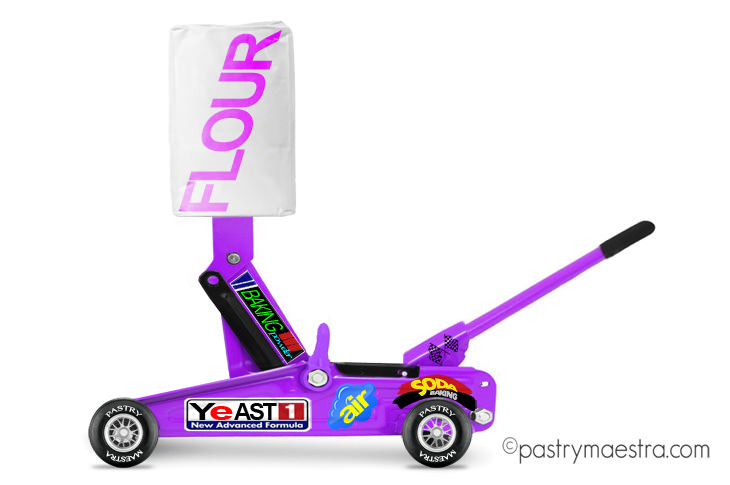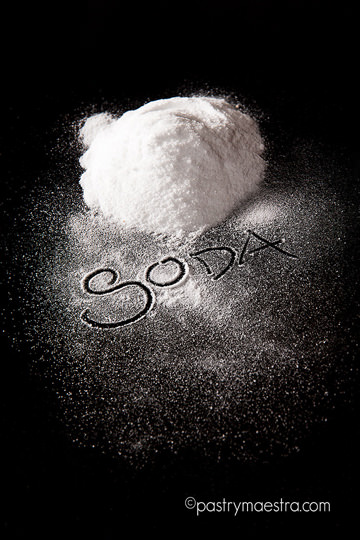

W
e have all experienced a cake disaster, I believe. You know, when it just doesn’t turn out as you planned it would. It didn’t rise well, maybe it is dense, hard or/and dry? Well, one of the most probable reasons for that could be the improper use of leavening agent, whether you used a natural one like yeast, or chemical leavening agents, such as baking soda or baking powder.
Leavening is production or incorporation of gasses in a dough or batter because gasses expand considerably when heated. As a result – baked products increase in volume, get shape and texture. There are three main gasses that we use in baking: carbon dioxide, steam, and air. Carbon dioxide is produced by yeast, baking soda, and baking powder. Steam occurs from the moisture in the batter, and air is incorporated into dough by whisking and mixing.
Carbone Dioxide Leavening Agents
Yeast
Yeast is a living organism, a single-celled fungus that feeds on carbohydrates in the dough (starches and sucrose) converting them into carbon dioxide and ethanol (alcohol). That process is called fermentation. Louis Pasteur, a French chemist and microbiologist, first explained the principle of fermentation among other microbiological discoveries and researches. Carbon dioxide gas stays “trapped” in the dough thanks to elastic gluten strands of the mixture. When heated, the bubbles of gas expand and leaven the dough. Yeast is most frequently used for making bread.
Yeast is sensitive to temperature and moisture, and the most convenient temperature for yeast is 24°C-35ºC (75°F-95°F). Bellow 2ºC (35°F) it becomes inactive or dormant, and above 59ºC (138°F) it dies. Moisture activates yeast cells and helps them to ferment.
Types of yeast

There are many varieties of yeast: beer yeast, wine yeast, baker’s yeast, etc. The most interesting for us are types of baker’s yeast, and there are two main types – fresh yeast and dry yeast.
- Fresh yeast or compressed yeast is soft and moist beige substance. It easily crumbles and has a fresh smell. To use fresh yeast, you should mix it with lukewarm water, or other liquid stated in the recipe, at room temperature (most often it’s milk) and stir well. When it dissolves, you can add the mixture to the dry ingredients. Fresh yeast must be used within a short time after opening, and has to be kept in the refrigerator, or it can be frozen for a period of up to four months. If you freeze it, defrost it the day before using it. You can substitute 20g (0.7 Oz.) of fresh yeast with 7g (0.25 Oz.) of active dry yeast. Never mix yeast with salt directly, salt will kill the yeast!
- Dry yeast is fresh yeast that was dried, so the yeast cells become dormant because of low moisture content. It becomes active when mixed with liquid. However, it doesn’t have to be mixed with liquid in the recipe, you can just add it to the flour, and it will work. Replace 1g (0.03 Oz.) of dry yeast with 3g (0.1 Oz.) of fresh yeast.
Baking Soda

Baking soda or sodium bicarbonate is a chemical leavening agent, white powder with slightly salty, alkaline taste. As a food additive in Europe, it has designation E500. Baking soda releases carbon dioxide if an acid and moisture are present. Heat is not necessary for activation of baking soda. Products that contain baking soda have to be baked immediately after mixing ingredients. Acids used with baking soda are buttermilk, sour cream, lemon juice and citrus fruits. You could even use honey and molasses because they contain so-called hidden acids. Baking soda is used in making pancakes, cakes, quick breads, soda bread, and other baked and fried foods.
Baking Powder

Baking powder is another chemical leavening agent, a mixture of baking soda and one or more acids (cream of tartar, sodium aluminum sulfate). It also contains starch to prevent lumping. The single-acting baking powder just needs moisture for activation. Double-acting baking powder first releases a small amount of gas upon contact with moisture, and second, the stronger release of gas happens when heated.
Baking powder is used for baking cakes, pancakes, quick breads, muffins, cookies and other desserts. The recommended quantity is 5g (0.18oz) of baking powder to raise a mixture of 125g (4.4 Oz.) flour, 250g (1 cup) of liquid and one egg (50g/1.8 Oz.).
Baking Ammonia
Baking ammonia or ammonium carbonate releases ammonia and carbon dioxide when heated. It also releases strong odor as it bakes. It was used as a precedent of modern baking soda and baking powder, for making cookies and crackers with low moisture content. It was used particularly in Europe, for making traditional cookies, such as Speculoos or Lebkuchen biscuits. It is also used as acidity regulator, and in Europe it has designation E503. Baking ammonia can be substituted with baking powder, but this may affect both the taste and texture of the finished product.
Mechanical leavening
During mixing, we incorporate air into all batters, but some products are leavened mostly or entirely by air. There are two methods of mechanical incorporating air into dough:
- Creaming method: when beating softened fat and sugar together, the air is incorporated because the sugar crystals cut through the fat and aerate it.
- Foaming or egg foam method: when beating eggs, egg whites or egg yolks with or without sugar, we incorporate air into them. The incorporated air expands when heated, and leavens the mixture.
Leavening with Steam
When moisture in the batter or the dough is heated, the result is steam. Steam is also an important leavening agent, especially in choux pastry. Eggs inside choux pastry, when cooked at high temperatures produce the steam, which leavens the dough.
So, you won’t need a crane, but if you want to master baking, you will need to know different techniques of leavening. Whether you use good old air, a natural yeast leavener, or chemical leavening agents, if you know how to use them, and how much to put, the cake disaster from the beginning will be avoided! And you will take a bite of perfectly spongy, light, moist and tasty cake, mmm…



